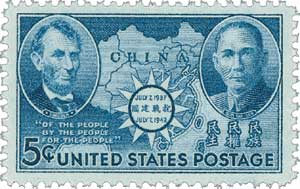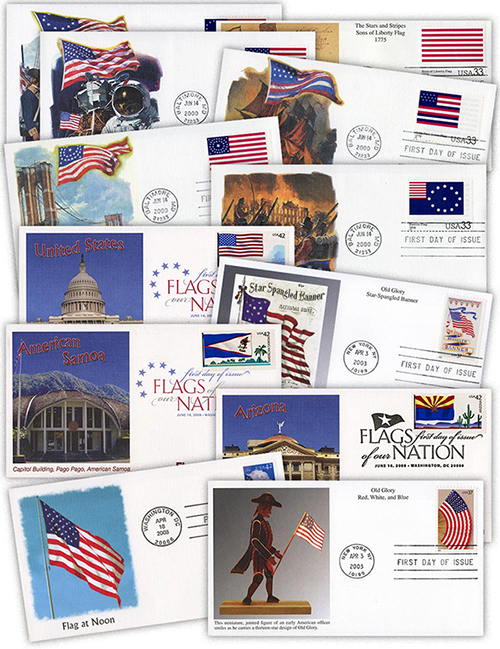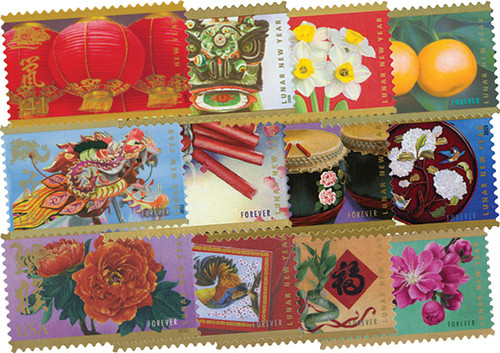
# 4435 FDC - 2010 44c Chinese Lunar New Year: Year of Tiger
Chinese New Year
44¢ Year of the Tiger
City: Los Angeles, CA
Printing Method: Photogravure
Perforations: Serpentine Die Cut 11
Color: Multicolored
On August 23, 1784, an American merchant ship unfurled the Stars and Stripes for the first time in China. The Chinese dubbed it the “Flower Flag,” and its passengers, “flower flag countrymen,” a name that endures today. Throughout our history, the American flag has gone by many names. The “Stars and Stripes,” “Old Glory,” and the “Star-Spangled Banner” are some of the most well-known. The unusual nickname, “Flower Flag,” dates to 1784. A year after the end of the American Revolutionary War, the United States was allowed to trade with China for the first time. Being able to import Chinese tea and goods was an exciting development for the new nation. In exchange, the US would bring 30 tons of American ginseng, a spice highly prized in China. Empress of China departed New York Harbor on February 22, 1784, to great fanfare including a 13-gun salute (for each state in the union). A few years later Philip Freneau captured the event in a poem. An excerpt reads: With clearance from Bellona won To countries placed in burning climes From thence their fragrant teas to bring On August 23, 1784, the American merchant vessel Empress of China sailed into the port of Canton, unfurling the Stars and Stripes for the first time in China. The locals were excited by the new ship and its flag that was “as beautiful as a flower.” Some sources also claim the reference was to the flag’s stars, which resembled Chinese daffodils. The ship became known as the “flower flagship” and the flag itself the Flower Flag. One account of the event recalled, “When the thirteen stripes and stars first appeared at Canton, much curiosity was excited among the people. News was circulated that a strange ship had arrived from the further end of the world, bearing a flag “as beautiful as a flower.” Everybody went to see the kwa kee chuen, or “flower flagship.” This name at once established itself in the language, and America is now called the kwa kee kwoh, the “flower flag country” — and an American, kwa kee kwoh yin – “flower flag countryman” – a more complimentary designation than that of “red headed barbarian” – the name first bestowed upon the Dutch.The Flower Flag




She spreads her wings to meet the Sun,
Those golden regions to explore
Where George forbade to sail before.
And islands of remotest times
She now her eager course explores.
And soon shall greet Chinesian shores.
Without the leave of Britain’s king;
And Porcelain ware, enchased in gold.
The product of that finer mould.

The phrase became widespread in China and the US became known as the flower flag country. Though they no longer use this designation for America, flower flag is still used today to refer to our countrymen and some other American objects. These include flower flag ginseng and Flower Flag Bank (Citibank).
Chinese New Year
44¢ Year of the Tiger
City: Los Angeles, CA
Printing Method: Photogravure
Perforations: Serpentine Die Cut 11
Color: Multicolored
On August 23, 1784, an American merchant ship unfurled the Stars and Stripes for the first time in China. The Chinese dubbed it the “Flower Flag,” and its passengers, “flower flag countrymen,” a name that endures today. Throughout our history, the American flag has gone by many names. The “Stars and Stripes,” “Old Glory,” and the “Star-Spangled Banner” are some of the most well-known. The unusual nickname, “Flower Flag,” dates to 1784. A year after the end of the American Revolutionary War, the United States was allowed to trade with China for the first time. Being able to import Chinese tea and goods was an exciting development for the new nation. In exchange, the US would bring 30 tons of American ginseng, a spice highly prized in China. Empress of China departed New York Harbor on February 22, 1784, to great fanfare including a 13-gun salute (for each state in the union). A few years later Philip Freneau captured the event in a poem. An excerpt reads: With clearance from Bellona won To countries placed in burning climes From thence their fragrant teas to bring On August 23, 1784, the American merchant vessel Empress of China sailed into the port of Canton, unfurling the Stars and Stripes for the first time in China. The locals were excited by the new ship and its flag that was “as beautiful as a flower.” Some sources also claim the reference was to the flag’s stars, which resembled Chinese daffodils. The ship became known as the “flower flagship” and the flag itself the Flower Flag. One account of the event recalled, “When the thirteen stripes and stars first appeared at Canton, much curiosity was excited among the people. News was circulated that a strange ship had arrived from the further end of the world, bearing a flag “as beautiful as a flower.” Everybody went to see the kwa kee chuen, or “flower flagship.” This name at once established itself in the language, and America is now called the kwa kee kwoh, the “flower flag country” — and an American, kwa kee kwoh yin – “flower flag countryman” – a more complimentary designation than that of “red headed barbarian” – the name first bestowed upon the Dutch.The Flower Flag




She spreads her wings to meet the Sun,
Those golden regions to explore
Where George forbade to sail before.
And islands of remotest times
She now her eager course explores.
And soon shall greet Chinesian shores.
Without the leave of Britain’s king;
And Porcelain ware, enchased in gold.
The product of that finer mould.

The phrase became widespread in China and the US became known as the flower flag country. Though they no longer use this designation for America, flower flag is still used today to refer to our countrymen and some other American objects. These include flower flag ginseng and Flower Flag Bank (Citibank).









